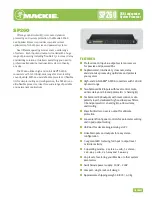
S1C63558 TECHNICAL MANUAL
EPSON
27
CHAPTER 4: PERIPHERAL CIRCUITS AND OPERATION (Oscillation Circuit)
4.3.6 I/O memory of oscillation circuit
Table 4.3.6.1 shows the I/O address and the control bits for the oscillation circuit.
Table 4.3.6.1 Control bits of oscillation circuit
Address
Comment
D3
D2
Register
D1
D0
Name
Init
∗
1
1
0
FF00H
CLKCHG OSCC
0
Dummy
R
R/W
R/W
CLKCHG
OSCC
0
∗
3
Dummy
0
0
–
∗
2
0
OSC3
On
OSC1
Off
CPU clock switch
OSC3 oscillation On/Off
Unused
General-purpose register
*1 Initial value at initial reset
*2 Not set in the circuit
*3 Constantly "0" when being read
OSCC: OSC3 oscillation control register (FF00H•D2)
Controls oscillation ON/OFF for the OSC3 oscillation circuit.
When "1" is written: OSC3 oscillation ON
When "0" is written: OSC3 oscillation OFF
Reading: Valid
When it is necessary to operate the CPU at high speed, set OSCC to "1". At other times, set it to "0" to
reduce current consumption.
At initial reset, this register is set to "0".
CLKCHG: CPU system clock switching register (FF00H•D3)
The CPU's operation clock is selected with this register.
When "1" is written: OSC3 clock is selected
When "0" is written: OSC1 clock is selected
Reading: Valid
When the CPU clock is to be OSC3, set CLKCHG to "1"; for OSC1, set CLKCHG to "0".
After turning the OSC3 oscillation ON (OSCC = "1"), switching of the clock should be done after waiting
5 msec or more.
At initial reset, this register is set to "0".
4.3.7 Programming notes
(1) It takes at least 5 msec from the time the OSC3 oscillation circuit goes ON until the oscillation stabi-
lizes. Consequently, when switching the CPU operation clock from OSC1 to OSC3, do this after a
minimum of 5 msec have elapsed since the OSC3 oscillation went ON.
Further, the oscillation stabilization time varies depending on the external oscillator characteristics
and conditions of use, so allow ample margin when setting the wait time.
(2) When switching the clock form OSC3 to OSC1, use a separate instruction for switching the OSC3
oscillation OFF. An error in the CPU operation can result if this processing is performed at the same
time by the one instruction.
(3) The internal operating voltage of V
D1
is fixed at 2.2 V. So it is not necessary to control the operating
voltage regardless of the operating clock selected.















































